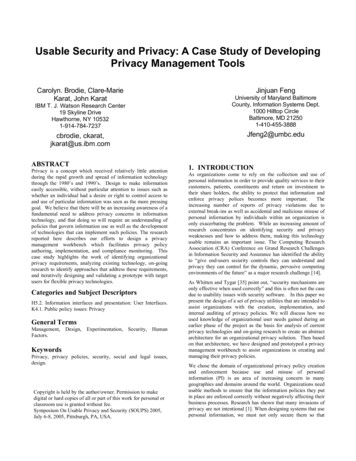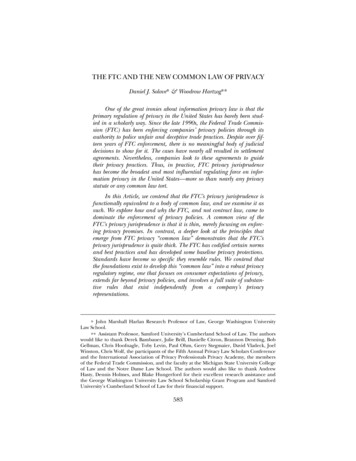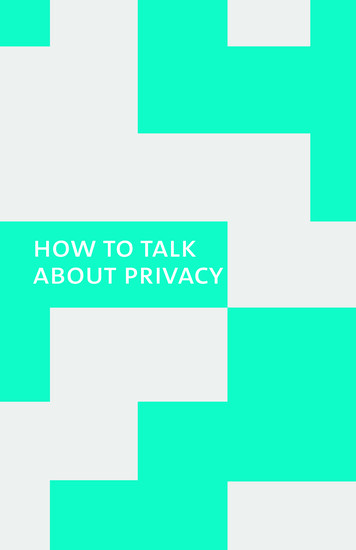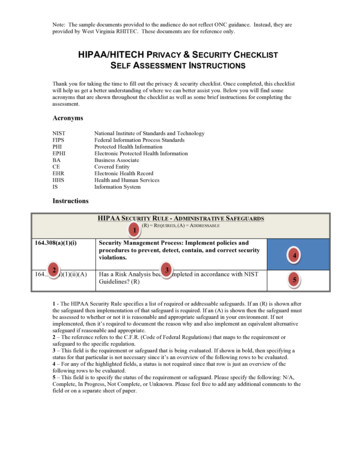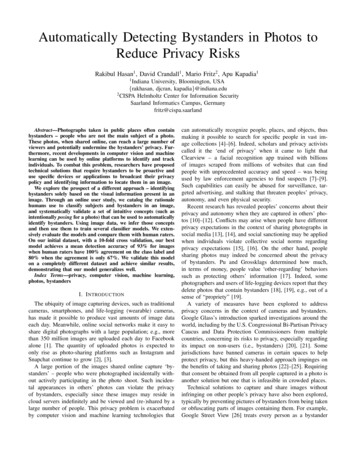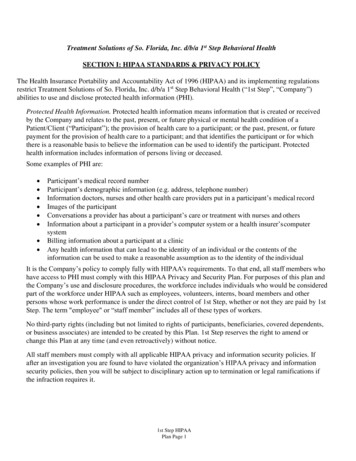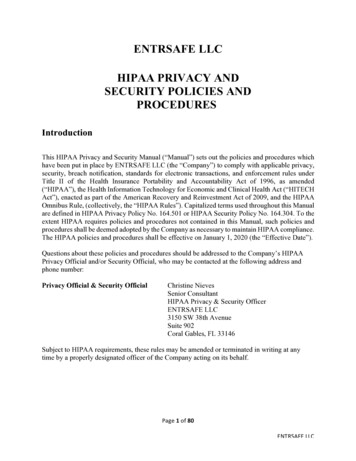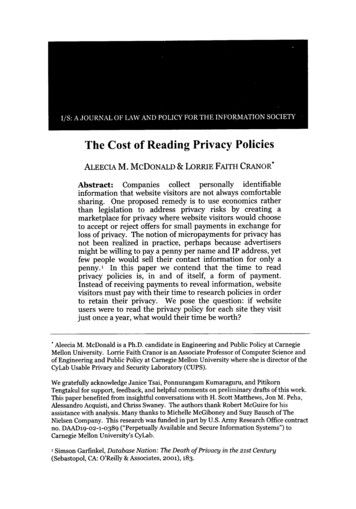
Transcription
The Cost of Reading Privacy PoliciesALEECIA M. MCDONALD & LORRIE FAITH CRANOR*Abstract: Companies collect personally identifiableinformation that website visitors are not always comfortablesharing. One proposed remedy is to use economics ratherthan legislation to address privacy risks by creating amarketplace for privacy where website visitors would chooseto accept or reject offers for small payments in exchange forloss of privacy. The notion of micropayments for privacy hasnot been realized in practice, perhaps because advertisersmight be willing to pay a penny per name and IP address, yetfew people would sell their contact information for only apenny. 1 In this paper we contend that the time to readprivacy policies is, in and of itself, a form of payment.Instead of receiving payments to reveal information, websitevisitors must pay with their time to research policies in orderto retain their privacy. We pose the question: if websiteusers were to read the privacy policy for each site they visitjust once a year, what would their time be worth?Aleecia M. McDonald is a Ph.D. candidate in Engineering and Public Policy at CarnegieMellon University. Lorrie Faith Cranor is an Associate Professor of Computer Science andof Engineering and Public Policy at Carnegie Mellon University where she is director of theCyLab Usable Privacy and Security Laboratory (CUPS).We gratefully acknowledge Janice Tsai, Ponnurangam Kumaraguru, and PitikornTengtakul for support, feedback, and helpful comments on preliminary drafts of this work.This paper benefited from insightful conversations with H. Scott Matthews, Jon M. Peha,Alessandro Acquisti, and Chriss Swaney. The authors thank Robert McGuire for hisassistance with analysis. Many thanks to Michelle McGiboney and Suzy Bausch of TheNielsen Company. This research was funded in part by U.S. Army Research Office contractno. DAAD19-o2-1-0389 ("Perpetually Available and Secure Information Systems") toCarnegie Mellon University's CyLab.'Simson Garfinkel, DatabaseNation: The Death of Privacy in the 21st Century(Sebastopol, CA: O'Reilly & Associates, 2001), 183.
I/S: A JOURNAL OF LAW AND POLICY[Vol. 4:3Studies show privacy policies are hard to read, readinfrequently, and do not support rational decision making.We calculated the average time to read privacy policies intwo ways. First, we used a list of the 75 most popularwebsites and assumed an average reading rate of 250 wordsper minute to find an average reading time of lo minutes perpolicy. Second, we conducted an online study of 212participants to measure time to skim online privacy policiesand respond to simple comprehension questions. We useddata from Nielsen/Net Ratings to estimate the number ofunique websites the average Internet user visits annuallywith a lower bound of 119 sites. We estimated the totalnumber of Americans online based on Pew Internet &American Life data and Census data. Finally, we estimatedthe value of time as 25% of average hourly salary for leisureand twice wages for time at work. We present a range ofvalues, and found the national opportunity cost for just thetime to read policies is on the order of 781 billion.Additional time for comparing policies between multiplesites in order to make informed decisions about privacybrings the social cost well above the market for onlineadvertising. Given that web users also have some value fortheir privacy on top of the time it takes to read policies, thissuggests that under the current self-regulation framework,targeted online advertising may have negative social utility.
2008]MCDONALD & CRANOR545I. INTRODUCTIONThe Federal Trade Commission ("FTC") supports industry selfregulation for online privacy.2 In the late 199os, the FTC decided thatthe Internet was evolving very quickly and new legislation could stiflegrowth. In particular, there were concerns that it was premature tolegislate to protect privacy before other mechanisms evolved,especially when business was expected to offer more effective andefficient responses than FTC staff could devise. The Internet was stillyoung, commerce on the Internet was very new, and legislators andregulators adopted a hands-off approach rather than risk stiflinginnovation. However, concerns remained about data privacy ingeneral and on the Internet in particular. For example, the FTCrecommended legislation to protect children's privacy, which led tothe Children's Online Protection Act ("COPPA") in 1998.3Prior to COPA, the FTC adopted Fair Information Principles("FIPs"), a set of ideals around data use. The notion of FIPs predatesthe Internet; several nations adopted differing FIPs in response toconcerns about credit databases on mainframes in the 1970s.4 WhileFIPs do not themselves carry the force of law, they provide a set ofprinciples for legislation and government oversight. In this way theyare similar to the Universal Declaration of Human Rights, in whichArticle 12 states the principle that "No one shall be subjected toarbitrary interference with his privacy, family, home orcorrespondence, nor to attacks upon his honour and reputation.Everyone has the right to the protection of the law against suchinterference or attacks," but leaves the specific legal implementationsof those ideals in the hands of individual nations.52 RobertPitofsky, Chairman of the Federal Trade Commission, "Privacy Online: FairInformation Practices in the Electronic Marketplace" (prepared statement before theSenate Committee on Commerce, Science, and Transportation, Washington D.C., May 25,2000), .3 RobertPitofsky, Chairman of the Federal Trade Commission, "Self-Regulation andPrivacy Online" (prepared statement before the Senate Committee on Commerce, Science,and Transportation, Washington D.C., July 27, estimony.pdf.4 KennethC. Laudon, "Markets and Privacy," Communications of the ACM 39, no. 9(1996): 96.5 UN General Assembly, UniversalDeclarationof Human Rights, art. 12, 1948,http://www.unhchr.ch/udhr/lang/eng.pdf.
546I/S: A JOURNAL OF LAW AND POLICYWVol. 4:3The five FIPs the FrC adopted in are a subset of the eight protections ensconcedin the Organization for Economic Co-operation and Development("OECD") Guidelines on the Protection of Privacy and TransborderData Flows of Personal Data. 6 The FIP of notice underlies the notionof privacy policies, which are mechanisms for companies to disclosetheir practices. In 1998, the FTC commissioned a report that foundwhile 92% of U.S. commercial websites collected some type of data,only 14% provided comprehensive notice of their practices.7 The FrCwas concerned that the FIP of notice/awareness was not faring well ondid not know where their data went orthe new Internet: consumers8what it might be used for.Voluntary disclosure formed the basis of an industry selfregulation approach to notice. Because privacy policies werevoluntary, there were no requirements for the existence of a policy letalone any restrictions as to the format, length, readability, or contentof a given privacy policy. In addition to the threat of regulatory actionto spur voluntary disclosure, the FTC also used fraud and deceptivepractices actions to hold companies to whatever content they didpublish. In essence, while a company was not strictly required to posta policy, once published, the policy became enforceable. In one casethe FTC brought action even without a privacy policy. WhenCartmanager surreptitiously rented their customer lists the FTCadvanced a legal theory of unfairness rather than fraud.9 Cartmanagerprovided online shopping cart software and worked with clients whopromised not to sell customer data. The FTC argued that even thoughCartmanager did not have a privacy policy of their own to violate, theystill violated the policies of their clients. 1 Organisation for Economic Co-operation and Development, "OECD Guidelines on theProtection of Privacy and Transborder Flows of Personal Data,"http://www.oecd.org/document/18/o,3343,en-2 6 49-34255-1815186 11 1 1,oo.html.7 Federal Trade Commission, "Privacy Online: Fair Information Practices in the Electronic6Marketplace," 4, .pdf.8 Ibid., 36.9 David A. Stampley, Managing Information Technology Security and PrivacyCompliance (Chicago: Neohapsis, May 2005), paper.pdf (linked to as "PrivacyCompliance").10 Federal Trade Commission, "Internet Service Provider Settles FTC Privacy Charges,"news release, March 10, 2005, http://www.ftc.gov/opa/2oo5/o3/cartmanager.shtm.
20o8]MCDONALD & CRANORThe FTC initiated a series of studies of hundreds of commercialwebsites to determine how well industry self-regulation worked inwhat became known as Internet sweeps. Year after year, the numberof companies offering privacy policies increased. By that metric itappeared the FTC was successful. However, multiple studies alsoshowed people were reluctant to shop online because they had privacyconcerns. 1 Recall that the Frc's charter is largely financial- barriersto new markets and commerce are a serious issue. The FrC turned totwo different innovative approaches, rather than legislation orregulatory action. First, they expressed great hope for online privacyseals.12 Two seal providers, TRUSTe and the Better Business Bureau(through BBBOnline), began certifying website privacy policies.TRUSTe requires companies to follow some basic privacy standardsTRUSTe also investigatesand document their own practices.consumer allegations that licensees are not abiding by their policies.3However, TRUSTe has come under criticism for not requiring morerigorous privacy standards. 14 In fact, one study showed thatcompanies with TRUSTe seals typically offer less privacy-protectivepolicies than those without TRUSTe seals.'5Second, the FTC encouraged privacy enhancing technologies("PETs") with the hope that PETs would put greater control directlyinto the hands of consumers. 6 PETs include encryption, anonymityOne particularlytools, and other software-based approaches.intriguing approach came from the Platform for Privacy Preferences("P3P") standard, which used privacy policies coded in standardizedmachine-readable formats. P3P user agents can determine for11Federal Trade Commission, "Privacy Online: Fair Information Practices in the ElectronicMarketplace," 2 (see n. 7).12 Pitofsky,"Self-Regulation and Privacy Online," 5 (see n. 3)."TRUSTe Program Requirements," http://www.truste.org/requirements.php(accessed January 19, 2009).13 TRUSTe,14 Jamie McCarthy, "TRUSTe Decides Its Own Fate Today," Slashdot (November 8, ml.15 Carlos Jensen and Colin Potts, "Privacy Policies Examined: Fair Warning or FairGame?," GVU Technical Report 03-04 (Feb. 2003): f.16Pitofsky, "Self-Regulation and Privacy Online," 5 (see n. 3).
548I/S: A JOURNAL OF LAW AND POLICY[Vol. 4:3customers if a given website provided an acceptable privacy policy.17Even though P3P support is integrated into popular web browsers,18unfortunately most users remain unfamiliar with the technology.ECONOMIC THEORIES OF PRIVACY POLICIESThe FTC started with a set of principles, almost akin to aframework of rights, and encouraged companies to protect theserights by adopting privacy policies. Economists also see utility inprivacy policies but from an entirely different basis.Advertising economics looks at ways to turn a commodity (e.g.,water) into a bundle of marketable attributes (e.g., from mountainsprings). There are three types of attributes. Search goods are thingsreadily evaluated in advance, for example color. Experience goods areonly evaluated after purchase or use, for example the claims of a haircare product. Credence attributes cannot be determined even afteruse, for example nutrition content of a food. One argument formandatory nutrition labels on food is that it converts nutritioninformation from a credence attribute to a search attribute:consumers can read the label prior to purchase.19 This argumentapplies equally well to online privacy. Without a privacy policy,consumers do not know if a company will send spam until after theyhave made the decision to provide their email address. With a privacypolicy, consumers can check privacy protections prior to engaging inbusiness with the site.Another economic perspective that leads to supporting privacypolicies is that since privacy is not readily observable, it cannot beproperly valued by the market place. Without privacy policies,companies have all of the information about their own practices and17LorrieF. Cranor, Praveen Guduru, and Manjula Arjula, "User Interfaces for PrivacyAgents," ACM Transactionson Computer-HumanInteraction(TOCHI) 13, no. 2 (June2006): 135.18CarlosJensen, Colin Potts, and Christian Jensen, "Privacy practices of Internet users:Self-reports versus observed behavior," InternationalJournalof Human-ComputerStudies 63, no. 1-2 (2005): 212.19Andreas C. Drichoutis, Panagiotis Lazaridis, and Rodolfo M. Nayga, "Consumers' Use ofNutritional Labels: a Review of Research Studies and Issues," Academy of MarketingScience Review, no. 9 (2006): 1.
2008]MCDONALD & CRANOR549consumers have none, leading to an information asymmetry. 20Information asymmetries are one potential cause of market failure.The canonical example is of a market for used cars: sellers know iftheir cars are in mint condition or are lemons, but buyers may not beable to tell.21 Consequently, buyers need to take into account the riskof getting a bad car, and will not pay top dollar for a great car just incase they are being taken for a ride.Privacy policies should help reduce information asymmetriesbecause companies share information with their customers. However,researchers also note that if the cost for reading privacy policies is toohigh, people are unlikely to read policies. Time is one potential cost,and the time it takes to read policies may be a serious barrier.22 Thisapproach assumes rational actors performing personal benefit-costanalysis, at least on an implicit level, to make individual decisions toread or skip privacy policies.23 If people feel less benefit readingpolicies than they perceive cost of reading them, it stands to reasonpeople will choose not to read privacy policies.One question then is what value to place on the time it takes toread privacy policies. There is a growing literature addressing themonetary value of time, starting in the mid-1960s.24 For example,urban planners estimate the value lost to traffic jams when deciding ifit makes sense to invest in new roads or other infrastructureimprovements. 25 As benefit cost analysis increased in popularity,government agencies found they had a hard time calculating economicvalue for "free" services like parks. One way to address their value isTony Vila, Rachel Greenstadt, and David Molnar, "Why We Can't Be Bothered to ReadPrivacy Policies Models of Privacy Economics as a Lemons Market," ACM InternationalConference ProceedingSeries 50 (2003): 403-407.20George A. Akerlof, "The Market for 'Lemons': Quality Uncertainty and the MarketMechanism," QuarterlyJournalofEconomics 84, no. 3 (1970): 488-500.2122Cranor, Guduru, and Arjula, "User Interfaces for Privacy Agents," 135-36 (see n. 17).23 Alessandro Acquisti and Jens Grossklags, "Privacy and Rationality in Individual DecisionMaking," IEEE Security & Privacy 3, no.i (January/February 2005): 24-30.Gary S. Becker, "A Theory of the Allocation of Time," The Economic Journal75, no. 299(September 1965): 493-517, available at http://www.jstor.org/stable/2228949.2425 Timothy Leunig, "Time is Money: A Re-Assessment of the Passenger Social Savings fromVictorian British Railways," The Journalof Economic History 66 (2oo6): 635-73, workingpaper available /pdf/LSTC/o9o5Leunig.pdf.
I/S: A JOURNAL OF LAW AND POLICY[Vol. 4:3to estimate the time people spend traveling to parks and the value ofthe time they spend enjoying the parks, which again requiresestimates of the value of time.26 We draw upon this body of work.In this paper we look at societal and personal opportunity costs toread privacy policies. Under the notion of industry self-regulation,consumers should visit websites, read privacy policies, and choosewhich websites offer the best privacy protections. In this way amarket place for online privacy can evolve, and through competitionand consumer pressure, companies have incentives to improve theirprivacy protections to a socially optimal level. In practice, industryself-regulation has fallen short of the FTC vision. First, the Internet isfar more than commercial sites or a place to buy goods. While it maymake sense to contrast the privacy policies of Amazon, Barnes andNoble, and O'Reilly to purchase the same book, there is no directsubstitute for popular non-commercial sites like Wikipedia. Second,8studies show privacy policies are hard to read,27 read infrequently,2and do not support rational decision making.29Several scholars extended the FTC's vision of an implicitmarketplace for privacy by examining ways to explicitly buy and sellpersonal information.Laudon proposed"[m]arket-basedmechanisms based on individual ownership of personal informationand a National Information Market ("NIM") in which individuals canreceive fair compensation for the use of information aboutthemselves." Under this plan, corporations could buy "baskets ofinformation" containing the financial, health, demographic or otherdata that individuals were willing to sell about themselves.3O Variansees privacy as the "right not to be annoyed" and suggests web-based26 Mira G. Baron and Liliya Blekhman, "Evaluating Outdoor Recreation Parks Using TCM:On the Value of Time" (North American Regional Science Meeting, Charleston, SouthCarolina, January 2002), http://ie.technion.ac.il/Home/Users/mbaron/E 21 BaronBlekhman Jan2 2002.pdf.27 Carlos Jensen and Colin Potts, "Privacy policies as decision-making tools: an evaluationof online privacy notices" (Proceedingsof the SIGCHI Conference on Human Factors inComputing Systems, Vienna, Austria, April 24-29, 2004); CHI 'o4ACM 6, no.1 (2004):477.Jensen, Potts, and Jensen, "Privacy practices of Internet users: Self-reports versusobserved behavior," 215 (see n. 18).2829 Acquisti and Grossklags, "Privacy and Rationality in Individual Decision Making," 2430 (see n. 23).3o Laudon, "Markets and Privacy," 99 (see n. 4).
2008]MCDONALD & CRANORcontracts to sell specific information for specific uses during a fixedtime frame.31 Yet no such market of micropayments for personalinformation exists. Garfinkel notes that in the current market place,where corporations re-sell information to other corporations,payments are already low. He estimates that payments to individualsfor their information would be worth about a penny per name, whichis far lower than most people would be willing to accept.3 2 SinceGarfinkel's analysis, the market for personal information has beenflooded with readily available information. Even stolen information isworth only about a tenth of what it used to fetch on the blackmarket.33 Full clickstream data sells for only 40 cents per user permonth,34 yet from the outrage when AOL released search term data toresearchers,35 it is a good guess that most people value their data at asubstantially higher rate than it currently sells for on the open market.With sellers demanding more than buyers will pay, there is no zone ofpossible agreement, and thus it is likely that no transactions wouldtake place.In this paper we explore a different way of looking at privacytransactions. What if online users actually followed the self regulationvision? What would the cost be if all American Internet users took thetime to read all of the privacy policies for every site they visit eachyear? We model this with calculations of the time to read or skimpolicies, the average number of unique websites that Internet usersvisit each year, and the average value of time, as we present in sectionII. In section III, we combine these elements to estimate the totalannual time to read policies as well as the cost to do so, both forR. Varian, "Economic Aspects of Personal Privacy" (faculty Working PaperDepartment of Economics, Univ. of California at Berkeley, rs/privacy. See sections "A simpleexample/search costs" and "Contracts and markets for information."31 Hal32 Garfinkel, DatabaseNation, 183 (see n. i).33Mark Trevelyan, "Stolen account prices fall as market flooded," news.com.au, July 15,2008, o23758-5o14111,oo.html.Henry Blodget, "Complete CEO: ISPs Sell Clickstreams for 5 a Month," Seeking Alpha,March 13, 2007, isps-sellclickstreams-for-5-a-month.3435 Andrew Kantor, "AOL search data release reveals a great deal," USA Today, August 17,2006, r/2oo6-o8-7-aoldatax.htm.
I/S: A JOURNAL OF LAW AND POLICY1Vol. 4:3individuals and nationwide. We discuss our findings and present ourconclusions in section IV.II. INPUTS TO THE MODELIn this section we develop a model to estimate the cost to allUnited States Internet users if they read the privacy policy once oneach site they visit annually. We model cost both in terms of time andthe economic value of that time.We estimate the annual time to read ("TR") online privacy policies asTR p*R*np is the population of Internet usersR is the average national reading raten is the average number of unique sites an Internet user visitseach yearSimilarly, we estimate the time to skim ("Ts") online privacy policiesasTs p * S *nS is the average time to skim a policyWe contrast reading to skimming because while some Internetusers might read privacy policies all the way through, studies in ourlab show that in practice, people may scan privacy policies for specificin learning rather than readinginformation they are interested6word-for-word.3policiesEstimating the economic value of time is more complex. As wediscuss in section II.C, based on literature in the value of time domain,leisure time is valued at a lower hourly rate than value of loss ofproductivity during work hours. We estimate time at home as 1/4 Wand time at work as 2W where W represents average wages.Consequently we estimate not just the annual number of unique36 Robert W. Reeder, Lorrie Faith Cranor, Patrick G. Kelly, and Aleecia M. McDonald, "AUser Study of the Expandable Grid Applied to P3P Privacy Policy Visualization"(Conferenceon Computer and CommunicationsSecurity, Washington, D.C., October2008); Proceedingsof the 7th ACM Workshop on Privacy in the ElectronicSociety (WPES'o8), Washington, D.C., Oct. 27, 2008: 53.
20o8]MCDONALD & CRANORwebsites, but also the proportion of sites that Internet users visit athome and at work.A. TIME TO READ OR SKIM PRIVACY POLICIESWe used two different methods to estimate the average time toread online privacy policies. First, we took the average word length ofthe most popular sites' privacy policies and multiplied that by typicalwords per minute ("WPM") reading speeds. Second, we performed anonline study and measured the time it took participants to answercomprehension questions about an online privacy policy. This allowsus to estimate time and costs both for people who read the full policyword for word, and people who skim policies to find answers toprivacy questions they have. In each case, we use a range of values forour estimates with median values as a point estimate and high andlow values from the first and third quartiles. 371. CALCULATED ESTIMATE TO READ POPULAR WEBSITE PRIVACYPOLICIESWe measured the word count of the 75 most popular websitesbased on a list of 30,000 most frequently clicked-on websites fromAOL search data in October,2005.38Because these are the mostpopular sites, they encompass the sorts of policies Internet userswould be most likely to encounter.As seen in Figure 1, we found a wide range of policy lengths from alow of only 144 words to a high of 7,669 words- about 15 pages of text.We used a range of word count values from the first quartile to thethird quartile, with the mean value as a point estimate.37 In this paper, the first quartile is the average of all data points below the median; thethird quartile is the average of all data points above the median. These are single valuesand not a range of values. Point estimates are our single "best guess" in the face ofuncertainty.Serge Egelman, Lorrie Faith Cranor, and Abdur Chowdhury, "An Analysis of P3PEnabled Web Sites among Top-20 Search Results' (Proceedingsof the EighthInternationalConference on ElectronicCommerce, Fredericton, New Brunswick, Canada,38August 14-16, 2006).
[Vol. 4:3IS: A JOURNAL OF LAW AND POLICY4.4.,,.,.,Figure 1: Probability Density Function ("PDF") and CumulativeDistribution Function ("CDF") of Word Counts in Popular WebsitePrivacy Policies.We calculated the time to read policies as the word length ofcommon privacy policies times 250 WPM, which is a typical readingrate for people with a high school education.39WordCountTime to ReadOne PolicyReadingRateShort Policy2,071I250 WPM 8 minutes(Median)2,514/250 WPM 10 minutesLong Policy(Third Quartile)3,112/250 WPM l2 minutes(First Quartile)Medium PolicyTable 1: Times to read entire privacy policies for average readers.39Ronald P. Carver, "Is Reading Rate Constant or Flexible?" Reading Research Quarterly18, no. 2 (Winter 1983): 199, available at http://wwwoJstor.org/stable/747 5 , 7 .
20o8]MCDONALD & CRANORAs seen in Table 1, we find that it takes about eight to twelveminutes to read privacy policies on the most popular sites, with apoint estimate of ten minutes per policy. These estimates may beslightly low due to the jargon and advanced vocabulary in privacypolicies. In addition, some people read more slowly online than onpaper, which may also make these time estimates slightly low.2. MEASURED TIME TO SKIM POLICIESInternet users might be more likely to skim privacy policies to findanswers to their questions, or to contrast between two policies, ratherthan to read the policies word-for-word as envisioned in the priorsection. We performed an online-study that asked participants to findthe answers to questions posed about privacy protections based on thetext of a privacy policy. We based our questions on concerns peoplehave about online privacy, as studied by Cranor et al.4o We asked fivequestions including "Does this policy allow Acme to put you on anemail marketing list?" and "Does the website use cookies?" Allanswers were multiple choice, rather than short answer, so the act ofanswering should not have substantially increased the time to addressthese questions.To ensure our results were not overly swayed by one unique policy,participants were presented with one of six different policies ofvarying lengths. In all, we had 212 participants from which weremoved 44 outliers.41 We found that the time required to skimpolicies does not vary linearly with length, as seen in Figure 2. Weselected one very short policy (928 words), one very long policy (6,329words) and four policies close to the typical 2,500 word length. Themedian times to skim one policy ranged from 18 to 26 minutes. Thelowest first quartile was 12 minutes; the highest third quartile was 37minutes. The three policies clustered near 2,500 words ranged in40 Cranor,Guduru, and Arjula, "User Interfaces for Privacy Agents," 167 (see n. 17).During online studies, participants are sometimes distracted by other tasks. Weeliminated data points that were clearly implausible, for instance, taking 5 hours tocomplete a set of tasks that typically takes 20 minutes. In similar studies we have also seenresponses indicative of "clicking through" the answers without reading the text. While wedid have a few very speedy respondents that could mathematically be identified as outliers,we chose to retain them. For example, 3 minute response time is possibly the product ofsomeone unusually good at the task, rather than someone who did not attempt tounderstand the material. In short, we favored removing and retaining outliers in ways thatcould slightly underestimate the times we measured.41
I/S: A JOURNAL OF LAW AND POLICY[Vol. 4:3median times from 23 to 24 minutes and did not show statisticallysignificant differences in mean Number of Words in PolicyFigure 2: Median times and inter-quartile ranges to skim one privacypolicy.In a prior study, we asked 93 participants to read an online privacypolicy from a publishing site- the same very short 928 word policy.We asked very similar questions but included two additional questionsand omitted the time to answer the first question as a training task.We found a far lower time: a point estimate of six minutes to scan aprivacy policy and find relevant information. This reflects anartificially low time because, as we have since discovered, the majorityof time spent answering questions is devoted to the very first question.Even though our follow up study started with a basic question,participants typically spent a third to half of their time on the veryfirst question.Arguably a good lower estimate of the time it takes to skim onepolicy is to look at the inverse of our first study: just look at the timefor the first question, provided it is a question that encourages42 We contrasted the 2,550 word policy to the three similar length policies using two-sidedt-tests assuming unequal variance; 95% confidence interval; p 0.518, o.69o, o.891.
2008]MCDO
("FIPs"), a set of ideals around data use. The notion of FIPs predates the Internet; several nations adopted differing FIPs in response to concerns about credit databases on mainframes in the 1970s.4 While FIPs do not themselves carry the force of law, they provide a set of principles for legislation and government oversight.
